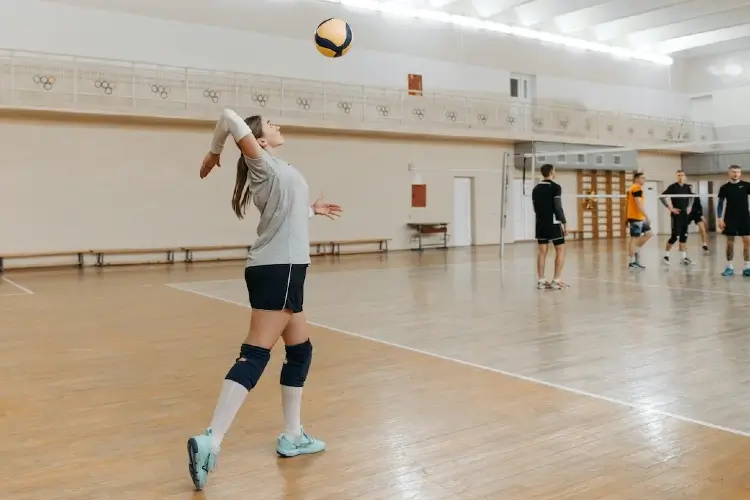Last Updated: October 19, 2023
Any beginner or expert volleyball player will agree that serving is the most critical stage of the game. A server will make the opponent’s job easy or difficult according to how the ball is served.
If you are looking for serving strategies to take your volleyball gameplay to the next level, the top techniques for a great serve outlined here will be handy.
Whatever serve you employ, you should be capable of getting the ball into your opponent’s court. It shouldn’t end there though; the served ball should be hard for your opponents to return or make good passes from, thus losing points.
When you see that your first serve wasn’t perfect, don’t lose your confidence – just make sure the second time around your serve is dynamic and more aggressive.
Top Volleyball Serving Strategies

The rule of thumb for your serve should be “go for it or just get it in,” which is important in building consistency.
Below are some of the best techniques to improve your volleyball serving ability.
1. Get it In
This isn’t a strategy you should use if you are an unskilled player. Firstly, you should be able to serve the ball to any specific zone on the court: 1, 2, 3, 4, 5, or 6 when directed by your coach.
Zones 1 and 2 fall to your left-hand side of the opponent’s side of the court. Zones 3 and 6 fall right in the middle. And lastly, zones 4 and 5 encompass the right-hand flank.
With this in mind, it’s very easy for the player serving the ball to target a particular player or area on the opponent’s court.
But this can prove hard for beginners since they may lack confidence or are scared. As a coach, you can tell your player to simply get the ball inside the court. Next, let the player try serving to the easiest region, Zone 6, and progress to the other zones.

2. Serve Short
Serving short or to the front row may be hard for an amateur player, but you can easily achieve this with proper exercise. Although longer serves are preferred by many players, using shorter serves is a nice strategy. You can either serve high or serve low and still be able to target the ball on the front row of the opponent’s court.
For instance, a shorter serving is mostly unexpected and can be utilized by hitting the front row’s 1 or 2 open slots. This can quickly get your other team off guard and weaken their capability to attack.
The short serve can be soft or hard depending on how you have measured your opponent’s front players’ strengths.
3. Serve Deep
In this scenario, you should serve high but place the ball deep. Many players find it hard to pass a deep serve, specifically the one that goes straight at their heads or flies past their heads. Only few players would be willing to move back to pass the ball.
So, the opponent player can try to pass the ball to the setter, but it doesn’t prove easy in most cases. The ball then ends up settling in between the players, thus bringing a big disruption to the offense. Alternatively, you can perform a low serve but still place your ball deep.
4. Mix Up the Serve
Although a playable serve is good, you must narrow it down to hitting different target areas on your opponent’s court. This will give your team more points or an upper hand in the game.
You can spice up your serving act by attacking between players, hitting the ball on the seams, or deep across the court. This type of attack can leave your opponents helpless and pray that you miss your serve.
5. Don’t Serve Directly to a Player
This can be called serving the ball to the seam, an open region between two players. Serving a ball in the seam leaves your opponents to communicate who will pass the ball. This certainly opens up room for an error, giving your team more advantage.
6. Increase Ball Velocity
You should hit the ball with more force despite the serve you choose. A ball that crosses the net with more force gives little time for the opponents to set themselves to give a good pass.
On the contrary, if you hit the ball with little force, it will go past the net with decreased velocity. This leaves room for your opponents to see the target area and return it quickly.
7. Make Drills
The secret to winning volleyball or any other sporting activity is thorough exercise. While some players may be good in either serving or passing the ball, it would be great if each player is skilled in both crafts. Nevertheless, depending on their expertise, your team coach will eventually place the players on the court.
During the first few minutes of the game, you should have figured out your strengths and weaknesses as a server. It doesn’t end there; find your opponent’s strengths and weak points, then work on them.
A reliable serving strategy will boost your team’s confidence and give it more game control.
How to Prepare for a Serve
To make a successful serve, you must be prepared physically and mentally.
Here are the key pointers to remember:
 Pick the correct serve technique. Deliberate on the serve; float or jump serve and stance that’s comfortable for you.
Pick the correct serve technique. Deliberate on the serve; float or jump serve and stance that’s comfortable for you. Select a target. Quickly view your opponent’s court and choose a reliable spot as your target; it can be at the back, in the front, or to a specific player.
Select a target. Quickly view your opponent’s court and choose a reliable spot as your target; it can be at the back, in the front, or to a specific player. Calm down. You can take a deep breath before serving to reduce anxiety and cool down nerves.
Calm down. You can take a deep breath before serving to reduce anxiety and cool down nerves. Visualize the serve by imagining that it will be a successful one.
Visualize the serve by imagining that it will be a successful one. Execute the serve
Execute the serve
Conclusion
Although playing volleyball involves different techniques like hitting, passing, serving, and blocking, serving is the first step. Therefore, a team’s serving ability can greatly influence the overall score. As a team, you should always learn and try look for ways of perfecting your serve.
You should know that not all serves are playable. Thus, serving the ball into the designated areas in your opponent’s court is mandatory. I recommended that you keep your eyes on the court’s sidelines when serving to keep the ball within the boundaries.
But hey, it’s not just about serving. Your serve should be hard and fast, but most of all challenging for the opponents to return.
